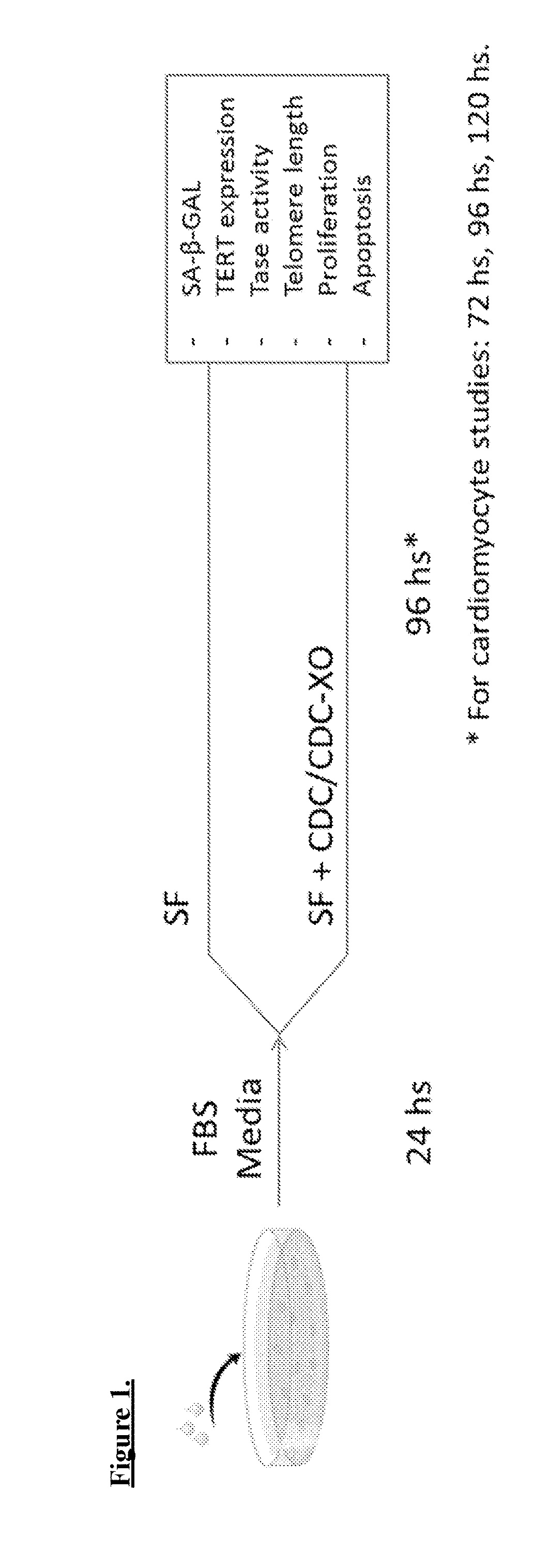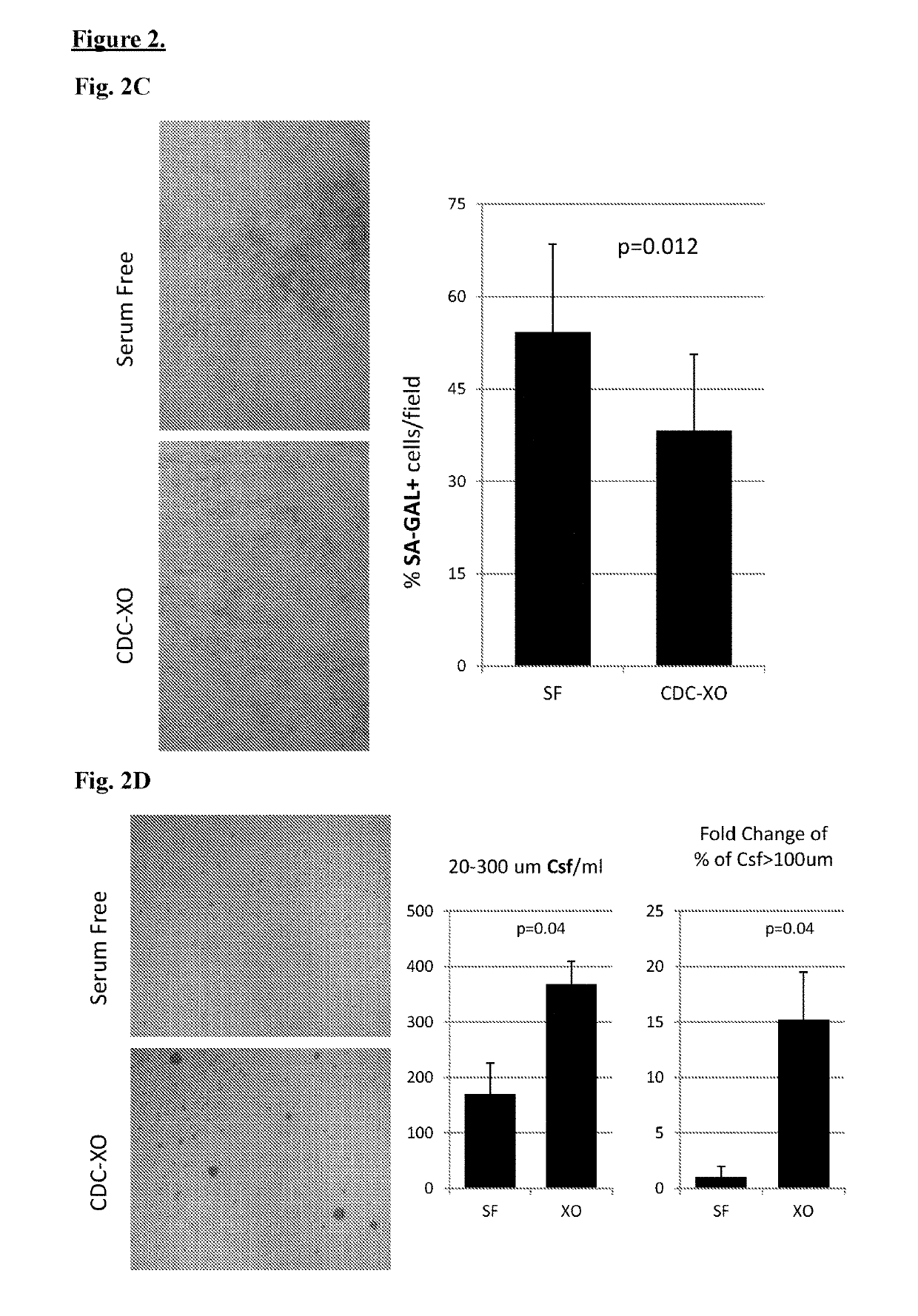Cardiosphere-derived cells and their extracellular vesicles to retard or reverse aging and age-related disorders
a technology of extracellular vesicles and cells, applied in the field of cells and extracellular vesicles, can solve the problems of increasing mortality, reducing senescence-associated beta-galactosidase expression, and creating a huge economic burden, so as to reduce senescence-associated beta-galactosidase expression, increase the expression of telomerase reverse transcriptase (tert), and increase the activity of telomeras
- Summary
- Abstract
- Description
- Claims
- Application Information
AI Technical Summary
Benefits of technology
Problems solved by technology
Method used
Image
Examples
example 1
CDC Culture
[0088]Cells from the right ventricular aspect of the interventricular septum can be obtained from healthy hearts of living or deceased tissue donors.
[0089]In brief, a sample such as a heart biopsy is minced into small fragments and briefly digested with collagenase. Explants were then cultured on 20 mg / ml fibronectin-coated dishes. Stromal-like flat cells and phase-bright round cells grow out spontaneously from tissue fragments and reach confluence by 2-3 weeks. These cells are harvested using 0.25% trypsin and cultured in suspension on 20 mg / ml poly d-lysine to form self-aggregating cardiospheres. cardiosphere-derived cells (CDCs) are obtained by seeding cardiospheres onto fibronectin-coated dishes and passaged. All cultures are maintained at 5% CO2 at 37° C., using IMDM basic medium supplemented with 20% FBS, 1% penicillin / streptomycin, and 0.1 ml 2-mercaptoethanol.
example 2
Media Conditioning and Exosome Purification
[0090]CDCs are conditioned in serum-free media for 15 days at 100% confluence. Aspirated media is then centrifuged at 3,000×g for 15 min to remove cellular debris. Exosomes were then isolated using Exoquick Exosome Precipitation Solution. Experimental design shown in FIG. 1.
[0091]Exosome pellets are resuspended in the appropriate media and used for assays. Expression of the conserved exosome marker CD63 is verified using ELISA. RNA content of exosome pellets can also be quantified using a Nanodrop spectrophotometer. For generation of miR-146a-deficient exosomes, CDC are transfected in suspension with miRIDIAN miR-146a hairpin inhibitor or a miRIDIAN hairpin control and seeded on to fibronectin-coated flasks. Exosomes are isolated from serum-free conditioned media (48 hr conditioning).
example 3
CDC Exosome-Mediated Protection of Telomerase-Telomere Axis
[0092]As shown in FIG. 2A, telomerase activity in extracts of heart explant-derived cells from old human donors after 96 hours was determined following telomeric repeat amplification protocol (TRAP) in four groups: the control group incubated with serum-free media (SF); cells co-cultured with young donor CDC alone or together with GW4869 inhibitor of exosome release (CDC and CDC-GW4869, respectively), using transwell membranes; cells co-cultured with young CDC-derived exosomes resuspended in serum-free media. As shown in FIG. 2B, representative images of cells subjected to telomere Q-FISH analysis. Nuclei are stained with DAPI and telomeres with specific CY3-labeled probe (red). Telomere length was analyzed by measuring the integrated optical density (i.o.d.) of the Cy3-channel within the nuclear borders after subtracting the background i.o.d. Results adjusted to the nuclear area are presented as well. Rejuvenation of heart ...
PUM
| Property | Measurement | Unit |
|---|---|---|
| time | aaaaa | aaaaa |
| time constant | aaaaa | aaaaa |
| diameter | aaaaa | aaaaa |
Abstract
Description
Claims
Application Information
 Login to View More
Login to View More - R&D
- Intellectual Property
- Life Sciences
- Materials
- Tech Scout
- Unparalleled Data Quality
- Higher Quality Content
- 60% Fewer Hallucinations
Browse by: Latest US Patents, China's latest patents, Technical Efficacy Thesaurus, Application Domain, Technology Topic, Popular Technical Reports.
© 2025 PatSnap. All rights reserved.Legal|Privacy policy|Modern Slavery Act Transparency Statement|Sitemap|About US| Contact US: help@patsnap.com



